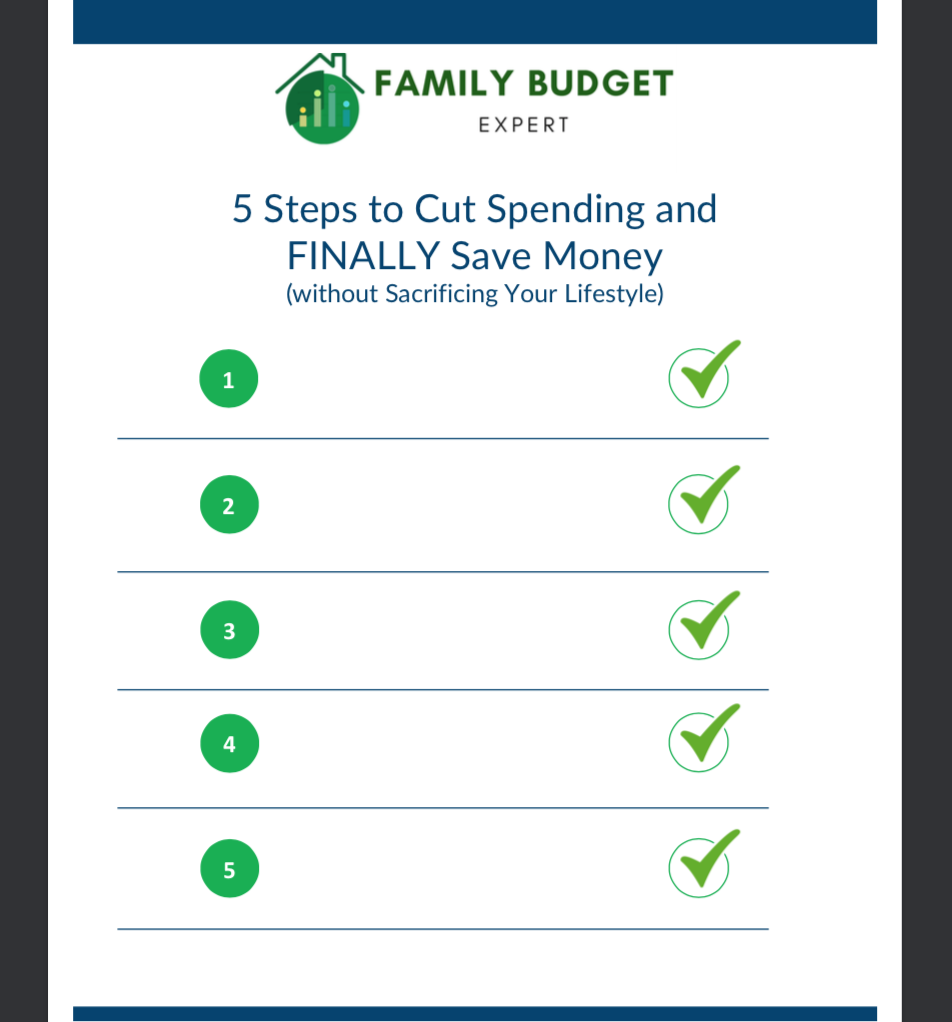

Creative Ways to Save Money
We could all use some help stretching our dollars further. There are plenty of ideas floating around, but I wanted to share some creative ways to save money that you never thought of before.
One tip here or there might not seem like much, but when you put them together, it’s no chump change.
We’re talking a lot of money, like thousands of dollars you can save each year.
We’ll cover the following areas:
- How to spend less on groceries – 8 tips
- How to save money going out to eat (or ordering in) – 8 tips
- Ways to save money each month – 5 tips
- Brilliant ways to save money you may not have heard of – 7 tips
Table of Contents
How to spend less on groceries (without changing where you shop).

We all know about Aldi’s & Walmart, but what if you like shopping at Target, Trader Joe’s, Whole Foods or your local grocery store? There are great ways to save money on groceries no matter where you buy them.
I won’t want to waste your time telling you to buy in bulk or go with the generic items. You already know that…oops, I guess I just did 🙂
Tip #1: Look through your freezer and refrigerator
I recently visited my parents in Ohio, and decided to help my mom get a little more organized after trying to put away the groceries.
We found a good 4 meals that could be made in the freezer alone. Some were leftovers. Others were prepackaged items.
Those are found meals that you don’t need to spend more money on! – Plus, let’s be honest. Your freezer needs to be cleaned out anyway 🙂
Tip #2: Check your pantry
This is the same principle as the freezer. You probably have some snacks, sides, and possibly entrées you prepare (pasta, canned soup, etc.). Guess what, you’ve already paid for it. Your pantry is chock full of money that you’ve already spent, so you might as well eat it.
And hey, if you have to eat Lucky Charms for dinner to save some money, that’s not so bad!
Tip #3: Do you normally throw food away? Eat leftovers or buy less.
Throwing away food is literally throwing your hard-earned money in the trash. Plus, it’s just plain wasteful.
According to RTS.com, we throw away 80 Billion pounds of food each year in this country totaling $161 billion. 30-40% of the US food supply gets tossed and it’s the #1 thing taking up our landfills.
That means the average person could cut the food on their plate by 20% and we’d still be throwing plenty away.
Not only is it a waste of money, but it’s also crazy to think about considering how many people have food insecurity.
If you don’t like leftovers, buy less food. If you like eating leftovers, feel free to keep the same amount. Just commit to eating the rest the following day.
Tip #4: Shop with a list
This weird thing kept happening to me before I started shopping with a list.
Sometimes, I’d remember that we needed mustard. I don’t even eat mustard, but I thought it should be a staple to have in case we had company.
Well, it got to be a problem when I put the groceries away and realized that I already had 4 unopened bottles already in the pantry. That’s like $10 just sitting there!
It also makes grocery shopping super fast! It used to take me more than an hour in the store and I hated it. Now using a list, I can be in and out in 20 minutes, and that’s shopping for our family of 5.
Save time and money using a grocery list (or app)!
Tip #5: Look at the price of the item before you put it in your cart (or Instacart).
How many times have you bought something at the grocery store without seeing how much it costs? Let’s go with all the time. At first, we are shocked by the bill and wonder what we spent our money on. Then we become numb and just get used to it.
We can do better!
Let me tell you from experience that once I started looking at the prices before putting them in the cart, it changed the way I shop dramatically! This leads to the next tip.
Tip #6: Choose the cheaper option
Oooo! those honeycrisp apples look so good!! But those pink lady apples are $2/lb cheaper and pretty good too.
Should I get the salmon or the tilapia? Well the tilapia is on sale for $9.99/lb and the salmon is $15.00/lb.
If you’d be perfectly happy (or happy enough) with either option, choose the cheaper one. It could save you $2 to $5 per item you buy. That’s some serious savings!
P.S. If you combine this advice with buying smaller portions, you can cut your spending in ½ on these items.
Tip #7: Buying in bulk isn’t always cheaper.
Sure you can save money buying per jar of pickles if you buy 10 of them. But if you only need 2 jars, you’re better off spending $3 for 2 ($1.50/jar) instead of $10 for 10 ($1.00/jar).
Regular prices are sometimes better than the buy-in-bulk store offers. Costco and Sam’s Club make their money selling you more things than you need.
Only buy items in bulk that you are absolutely positive you will eat every single item in a reasonable amount of time. Be wary of bulk fruits and veggies, because it might end up going bad before you get through it.
Tip #8: Look at the itemized receipt after you check out.
Wonder why your grocery bill is so high? Maybe you’re just used to the normal total when you checkout.
Chances are you can make some different choices that won’t affect your meal planning or the stuff you normally keep in stock.
Scan down the list and see where the pricier items are. Decide if it’s worth the price to you or not.
For example, we used to love buying pine nuts, toasting them and putting them in salads. Then I saw that they’re like $10/bag! I had no idea until I scanned the receipt.
Maybe there’s a cheaper alternative next time you grocery shop. (We switched to pecans part of the time which were half the price.)
How to save money going out to eat (or ordering in)

There are definitely creative ways to save money when we go out or order in.
In fact, this is where a bunch of food waste happens, because the portion sizes can be pretty huge.
I’m not going to mention things like going out less often or coupon clipping. Those are self-explanatory.
Tip #1: Use up your gift cards
We all have them. They’re just sitting around waiting to be used up. It’s just like having cash on hand but you can only use it at that particular restaurant.
Make your dining choices based upon where you have a gift card. You won’t have to spend money out of pocket to eat which is a good thing.
Pro tip: Gift cards can seem like free money and we might order more than we need. Try to stretch them out just like you would if it were “real money”.
Tip #2: Order one less item
Take a look at your order before you place it either online or when you’re out. Choose one less item that you can cut out.
It could be an appetizer, a drink, or even splitting an entree (with someone who lives with you during COVID-19).
Tip #3: Pick the cheaper option.
This is similar to the grocery store. If there are two entrées that look appealing, choose the less expensive one. Most of the time, it could save you $5. When you include tax and tip, it could be closer to $7.
If both you and your spouse/partner do that, you can save close to $15 on your dinner bill on this alone.
Tip #4: Skip the combos.
This is a pretty sneaky thing that companies do. It can make you feel like you’re getting a deal, but you’re really just buying more than you probably want and spending more money than you would if they didn’t offer the combo.
Tip #5: Skip the soda. Get water instead.
It’s pretty self-explanatory and can save you $2-$3 per person per meal even at the fast food joints. Plus, it’s the healthier choice.
Tip #6: Downgrade the size
Look, if you really need the venti, then go for it. I don’t want to get in between you and your favorite coffee shop but if you could just try…and I mean try to order the smaller size a few times and see how it goes.
The same applies to your fries, size of sandwich, and that movie theater popcorn (when they open back up).
Tip #7: The kids can split a meal…and so can you.
Unless your kids are high school boys with incredible appetites, chances are that one order of chicken fingers and fries can be split between two kids.
I LOVE pizza. It’s always my birthday meal. Now, my wife and I share one. It’s better for the wallet and waste line.
Plus, isn’t it romantic on a date night to split a meal?
This tip could cut your bill in half.
Tip #8: Order in the main course, but make the sides at home
This is something we do quite a bit.
We’ll order in something like pizza, sushi, mediterranean or asian food but fill out the plate with what we have at home.
Skipping the sides can cut your bill by about a 33%.
Ways to save money each month

Let’s take a look at our monthly subscriptions and some financial bills. We can save extra money each month by negotiating, cancelling, and examining them.
Tip #1: Call your cable company to cancel…but don’t cancel.
Call your cable provider and select the option to cancel, because you’ll get someone right away. Tell them that you like your services but your monthly fee is too high. They usually offer you a great deal at that point.
It’s an easy way to save $10, $20, $30 per month with just a phone call.
Tip #2: Cancel, yes cancel, your least favorite streaming services.
Do you really need Netflix, Amazon Prime, Hulu, Disney+, HBO, Showtime & the premium cable option? My guess is that there’s one you could live without.
This might help you make the choice. Which one did you subscribe to so you could binge watch a season and now it’s over? Cancel it. That’s $8/month.
“It’s only $8. I’ll just keep it.”
Why give that money to someone else when it would be better served staying in your pocket? The price doesn’t matter. $1 is $1.
Tip #3: Shop your home and auto insurance.
Chances are you might be paying too much if you haven’t reviewed it lately. I’m not saying you should decrease your coverages to save money unless you and the agent decide it’s a good idea, but you could get the same coverage for less.
Check out Policygenius or Zander to compare across companies.
Tip #4: Look at replacing your permanent life insurance (whole life) with term.
I won’t go into details, but whole life insurance is a VERY EXPENSIVE way to insure and invest. The fees and commissions are higher than pretty much any other alternative, and there are some other traps in how you can use the cash value.
Most people are better off with term insurance and investing the difference. Take a look with cancelling the policy only after you have other adequate life insurance in place (hopefully term).
You can check out Zander or Policygenius to shop around. Do not shop with your current life insurance agent. They will try to keep you in (or maybe even try to sell you more).
Tip #5: Refinance your mortgage if you can get a better rate
Refinancing is a great way to lower your monthly payment. If you have a rate close to or above 4%, refinancing can save you money on interest each month.
Just remember that if you’re 5 years into a 30 year mortgage, refinancing to a fresh 30 year will reset the clock and add 5 years to your current trajectory. A good mortgage banker will help you run the numbers.
If you live in Missouri or Ohio, reach out my favorite mortgage guy Robert Heideman.
Brilliant ways to save money

Here are some less conventional ways to save money. Some I’ve learned over the years, some I created as ideas bubbled up working with clients. You may not have heard of some of these before.
Tip #1: Use the public library for music, books, and movies
I’d like to thank my father-in-law for this tip.
I used to buy all sorts of books and movies $10 to $20 at a time. Little did I know that the library has books and movies that we can borrow for free! Ok, maybe I knew but I just didn’t think about it.
The public library has pretty much everything you need for free if you can wait a few days. Now it’s my go-to. If there’s a book I really want to buy, I’ll get it from the library first, read it, and if I like it, I’ll buy it to have on hand.
Like audiobooks? Many libraries have an app where you can download them for free, then “return” them when you’re done.
As for movies, the library is full of DVDs including the newest releases. If you have a DVD player, it’s a great move.
Most libraries have an app where you can reserve what you’re looking for. Our local library here in St Louis is doing curbside pickup for this.
It has also been a lifesaver as my kids have been home for 150 straight days and counting…
Tip #2: Sell things easily on Decluttr
Do you have old CDs, DVDs, books, electronics? Check out Decluttr.I used it about a year ago and it was super easy.
You just download the free app, scan the barcode on the item, and voilå! It will tell you how much they’ll buy it for. They’ll give you a label to print out. Once they receive it, you get a check in the mail!
Just so you know, some of the prices they offered seemed shockingly low, but then I cross referenced with eBay and they were comparable, so don’t let the sunk cost keep you from getting cash in your pocket today and getting rid of stuff you no longer need or use.
Tip #3: Count how many times you buy something each day.
This is a little trick I use with my clients that helps them spend less without much thought.
Rather than focusing on the dollar amount, they count the number of times they buy something.
Morning coffee purchase? That’s 1. Buy something on Amazon? That’s 2. Ordering in a meal? That’s 3.
If you count 5 or more, then chances are you are spending too often during the day. (I know, shopping online makes spending money so easy!)
See if you can cap it at 3-4 per day as a couple (2-3 as an individual). Once you get there, you’re done for the day.
You can budget for the number of purchases instead of the dollars spent. For example, if you know you are going to order food tonight, save one purchase in your daily budget for the evening.
Tip #4: Focus on the total cost, not the monthly payment
It seems like everything can be put on a payment plan. Why do you think companies offer it? Have you noticed that the years of payments are getting longer and longer? “It’s only $X per month!” is a much easier sell.
Auto loans, for example, used to be a 5 year term or less. Now they’re 7 year terms. The math essentially means that the payment is the same whether you buy a $25,000 car on a 5 year payment is the same as a $35,000 car on a 7 year payment.
Did you catch that?
The monthly payment doesn’t mean squat. They’re just trying to hide the fact that you’re going to spend $10,000 more on a car. That’s a ton of money! What else could you do with $10,000?
Forget the payment. Take the total cost difference and decide whether it’s worth it to you.
Tip #5: Reframe the cost of upgrading a big purchase
Let’s stay with the car example. The difference between spending $25,000 and $35,000 might not seem like much when you’re looking at the large numbers but…It’s $10,000!
Reframe the difference by asking the question, “What would I do if I had an extra $10,000?”
Would you take a family vacation or 2 or 10? Pay off credit card debt? Build up your emergency fund?
When you reframe the price difference, you will naturally spend less money because there’s most likely a better option for the money.
Tip #6: Track your spending
This is by far the #1 habit to set up if you want to save more money.
It’s actually one of 5 short-term financial goals you can set for yourself that requires no money at all.
It’s more important than budgeting because it makes you aware of your spending habits.
Use an online budgeting tool like Mint, YNAB, EveryDollar or one of the other gazillion ones out there and start getting a handle on where your money is going. You’ll be surprised and equipped with the info to make changes to save more money.
Tip #7: Use The 50/50 Rule
Anytime money comes our way, we feel the pull between wanting to spend it all and feeling like we should pay off debt, save, or invest it.
Personal finance experts tell us we should save everything and never spend. That’s no fun at all!
Take half of what you get from a pay raise, bonus, tax refund, etc and add it to what you’re currently doing to build your wealth.
Automate it by setting up an automatic transfer to your savings account for example.
Take the other half and feel free to spend it guilt free. It’s that easy!
It’s definitely one of the most creative ways to save money without sacrificing your lifestyle.
Get Budget Help & Save More Money Today
Using just a few of these tips can help you save money fast on your monthly expenses. Sometimes, we need a little more help and accountability.
If you feel like you need budget help, that is exactly what I do with my clients, and I’d be happy to help you figure it out.
My average client cuts their spending by 18% sustainable and without feeling like they’re making big sacrifices to their lifestyle.
Not only will we help you save more money, but we’ll also help you figure out what to do with it (save, invest or pay off debt).
Let’s start with a 30 minute conversation, so I can hear your biggest challenge and see how I can help.
Not ready to talk but want budget help?





